

7 Key Points on Where Can Emotional Support Dogs Go Anywhere
by Lena Park
Last updated: August 19, 2025
Verified and Approved by:
Angela Morris,
MSW, LCSW
Fact Checked

Overview
Emotional support dogs hold specific legal protections that grant them access to no-pet housing under the Fair Housing Act. However, it is important to recognize that they do not possess the same rights as service dogs in public spaces. This distinction can be challenging for many ESA owners, who may feel anxious about their rights and the potential barriers they face. Understanding these legal nuances is crucial for ensuring that emotional support dogs can accompany their owners where permitted.
As individuals navigate the complexities of housing and public spaces, it is essential for ESA owners to communicate proactively with landlords and businesses. This can be a daunting task, but it is a vital step in ensuring that their beloved companions can provide the emotional support they need. By fostering open dialogue, ESA owners can alleviate some of the stress associated with these interactions, ultimately enhancing their quality of life.
Remember, you are not alone in this journey. Many individuals face similar struggles, and there are resources available to help you advocate for your emotional support dog. By taking these proactive steps, you are not only ensuring your rights but also nurturing the bond that provides you with comfort and companionship.
Introduction
Navigating the world with an emotional support dog can be a complex journey, filled with uncertainty and challenges. Many individuals face emotional struggles that can feel overwhelming, especially when it comes to understanding the varying regulations that govern their beloved companions’ presence in public spaces.
While these cherished animals provide crucial emotional stability, it’s important to recognize that they do not enjoy the same access rights as service dogs under the Americans with Disabilities Act. This article aims to explore the essential guidelines and legal protections surrounding emotional support dogs, highlighting where they are permitted and outlining the responsibilities of their owners.
As the landscape of emotional support animal regulations continues to evolve, it’s natural to wonder:
- Can emotional support dogs truly go anywhere?
- What must their owners know to ensure a smooth and supportive experience?
Rest assured, we are here to provide clarity and guidance on this journey.
Define Emotional Support Dogs and Their Legal Status
A therapy dog serves as a comforting companion, offering mental stability to individuals navigating the challenges of anxiety or depression. Unlike assistance dogs, which are specially trained to perform tasks for people with disabilities, therapy animals are not recognized as service animals under the Americans with Disabilities Act (ADA). Nonetheless, they receive certain protections under the Fair Housing Act (FHA) and the Air Carrier Access Act (ACAA). The FHA allows Emotional Support Animal (ESA) owners to reside with their animals in housing that typically prohibits pets, freeing them from pet deposits and fees. For smoother acceptance, it’s advisable to obtain an ESA letter that is less than a year old.
Emotional support animals do not require specialized training; their primary role is to provide emotional support, validated through documentation from a licensed mental health professional. At Wellness Wag, we are dedicated to empowering individuals by offering accessible consultations for obtaining an Emotional Support Animal Letter, ensuring that clients can confidently embark on their journey toward companionship and support.
It’s crucial to familiarize yourself with local regulations, as some states impose additional requirements or protections for emotional support animals. For instance:
- California and Montana mandate a 30-day therapeutic connection with a licensed mental health professional before issuing an emotional support animal letter.
- Other states may impose stricter penalties for misrepresentation of such animals.
Understanding these nuances can significantly aid ESA owners in navigating their rights effectively. Additionally, landlords may charge fees for damages caused by an ESA if the animal is not well-behaved. Importantly, as of January 2021, the ACAA no longer extends protections to emotional support animals on flights.
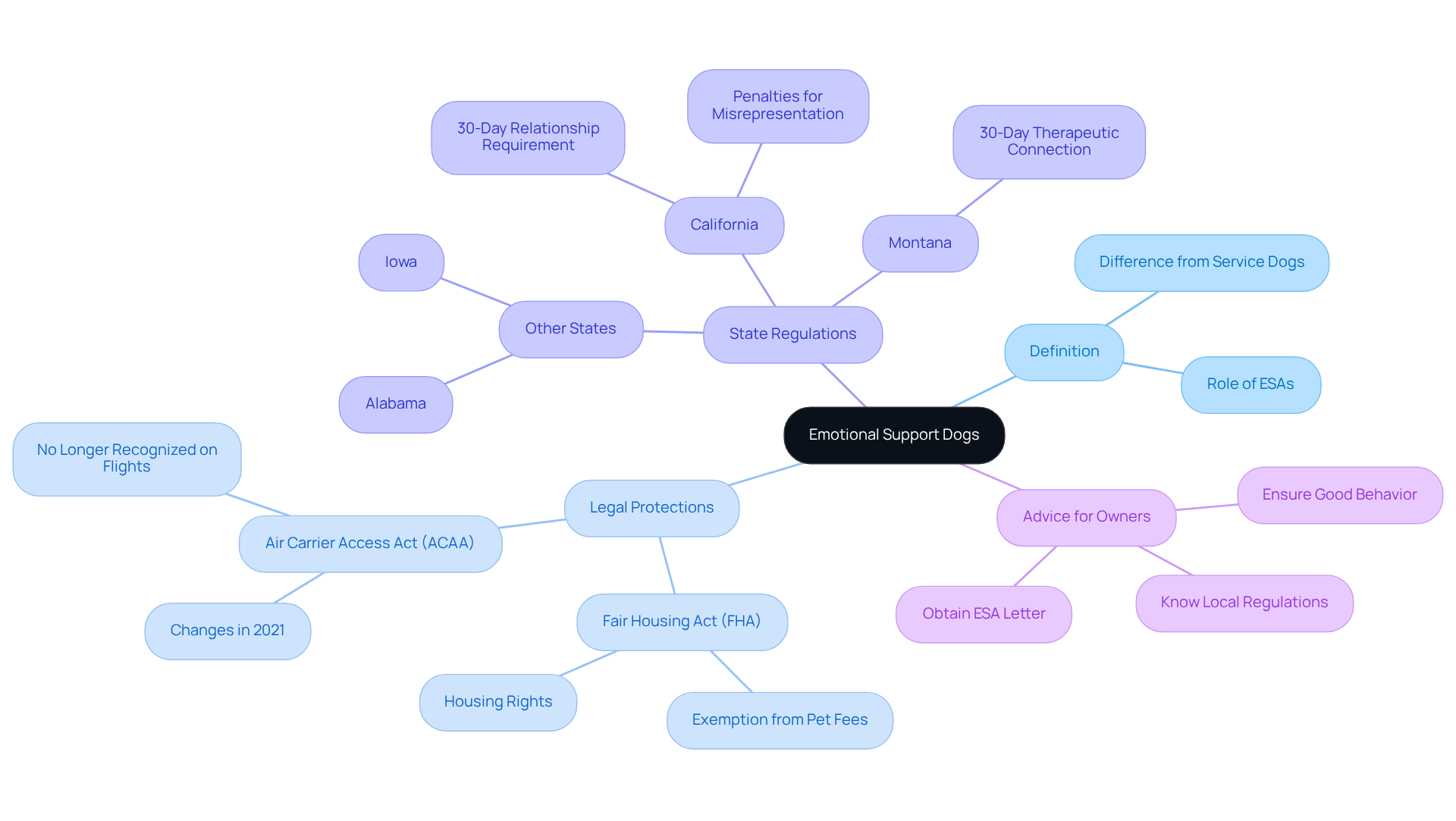
Identify Locations Where Emotional Support Dogs Are Permitted
Under the Fair Housing Act (FHA), Emotional Support Animals (ESAs) are allowed in no-pet housing, provided that tenants present valid documentation from a licensed mental health professional. This legal framework is designed to protect individuals with disabilities from discrimination, ensuring they can live with their emotional support animals without facing additional fees or limitations. It’s a vital step towards fostering a nurturing environment for those who need it most.
Air travel regulations for emotional support animals can vary significantly by airline, which can add to the stress of traveling. For instance, under Air Canada’s travel requirements, emotional support animals can accompany their owners, but specific guidelines must be followed. Passengers are permitted to bring only one cat or small dog in the cabin, and the pet must be at least 12 weeks old and fully weaned. It’s crucial to remember that pets must remain in their carriers at all times during the flight. Additionally, travelers should arrive at least 30 minutes early for check-in, as self-service kiosks are not available when traveling with a pet. Always verify the airline’s policies prior to travel, as some airlines may require documentation confirming that the ESA is healthy and trained for public settings. This preparation helps alleviate travel anxiety for both the owner and their furry companion.
The question of whether can emotional support dogs go anywhere is important, as they do not enjoy the same access rights as service dogs, but many businesses may still permit them on their premises. It’s always advisable to ask beforehand about whether emotional support animals can emotional support dogs go anywhere to avoid any misunderstandings. This proactive approach can help ensure a smoother experience for everyone involved.
Workers wishing to bring their therapy animals to work should engage in open conversations with their employers about the company’s guidelines on such animals. Certain workplaces may embrace emotional support animals to enhance employee well-being, particularly in environments that prioritize mental health. This dialogue can pave the way for a more supportive workplace culture, fostering a sense of belonging and care for all employees.
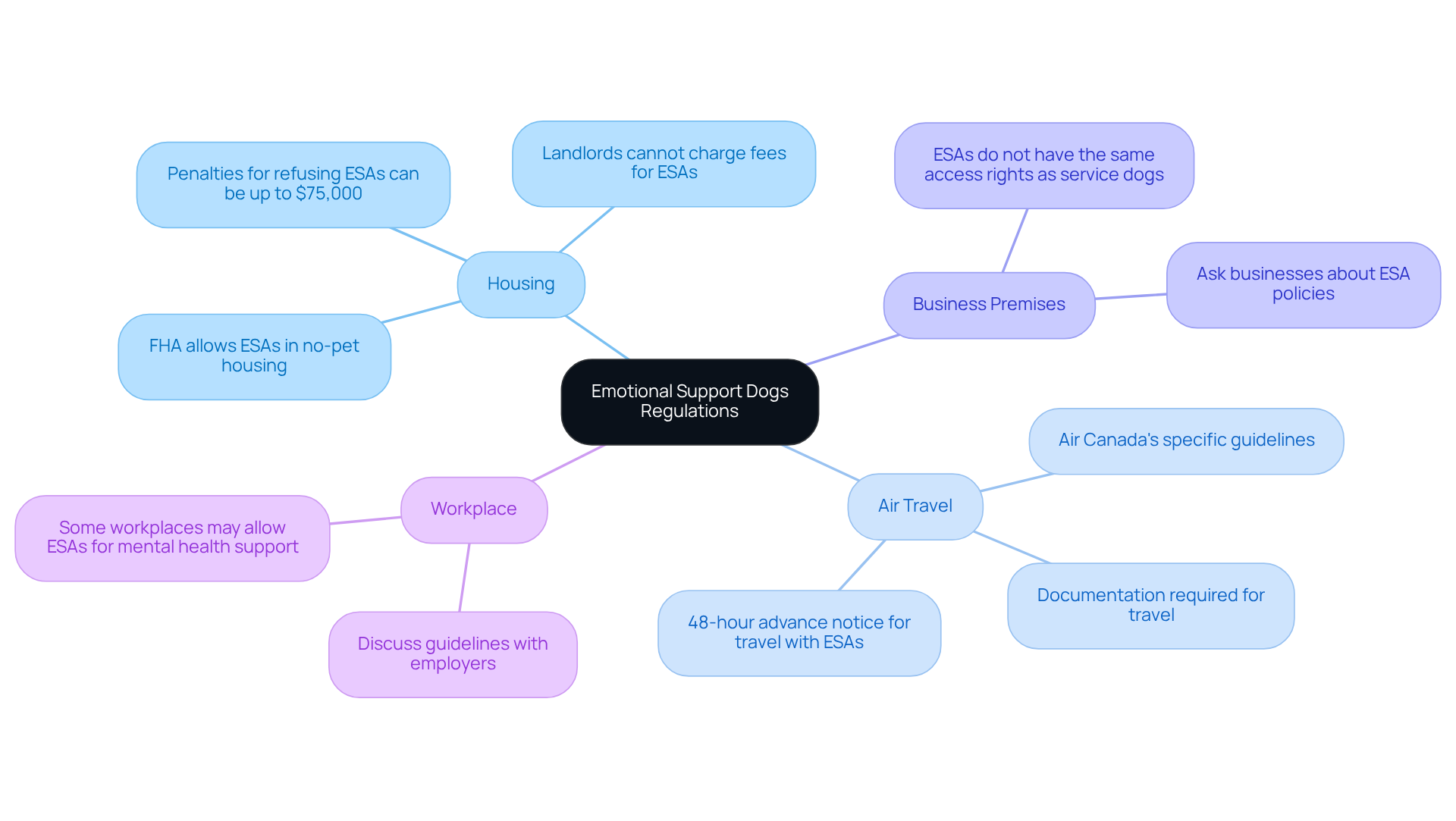
Outline Responsibilities of ESA Owners in Public Spaces
Always remember to keep your emotional support dog on a leash or harness in public spaces, especially considering where can emotional support dogs go anywhere. This practice not only ensures safety but also aligns with regulations that require control over animals in shared environments. For many students with disabilities, an Emotional Support Animal offers vital comfort by alleviating symptoms related to their condition, leading to the question of whether can emotional support dogs go anywhere. Therefore, it is essential for ESA owners to maintain control in public settings to foster a sense of security for everyone involved.
Cleaning up after your ESA is a simple yet impactful way to promote a hygienic atmosphere for all. Responsible pet ownership not only reflects positively on the ESA community but also helps mitigate any negative perceptions that may arise. This duty is crucial in nurturing an environment where emotional support animals can thrive and be embraced by those around them.
Ensuring your ESA is well-behaved and does not disrupt others in public settings is equally important. A well-mannered dog enhances the experience for everyone and highlights the beneficial role of emotional support animals in our society. Studies show that regular interaction with pets can significantly reduce anxiety levels, making it vital for ESA owners to encourage calm behavior in their dogs.
Be prepared to explain the role of your ESA to those who may not fully understand its purpose. Many individuals are unaware of whether emotional support dogs can go anywhere under the legal protections granted by the Fair Housing Act and the Americans with Disabilities Act. Sharing this information can foster understanding and acceptance, which is essential for students who rely on assistance animals for comfort and support.
Research indicates that approximately 18% of pet owners in the U.S. have emotional support animals, reflecting a growing awareness of their mental health benefits. However, it remains crucial to comply with public behavior standards to maintain this positive trend. This statistic underscores the importance of responsible ESA ownership in public spaces, reminding us all of the shared responsibility we have.
Animal behaviorists emphasize that dogs often reflect the character of their owners, highlighting the significance of training and socialization. As noted by experts, a well-trained ESA not only benefits its owner but also contributes to a more harmonious public environment. This reinforces the need for ESA owners to be diligent in their responsibilities, ensuring a positive experience for everyone.
In public areas, one may wonder can emotional support dogs go anywhere while ensuring they exhibit calm and controlled behavior. Instances of ESAs engaging positively with their surroundings—such as sitting quietly beside their owners or responding to commands—demonstrate their training and the bond they share with their handlers. This showcases the essential role they play in supporting mental health and the comfort they provide to those in need.
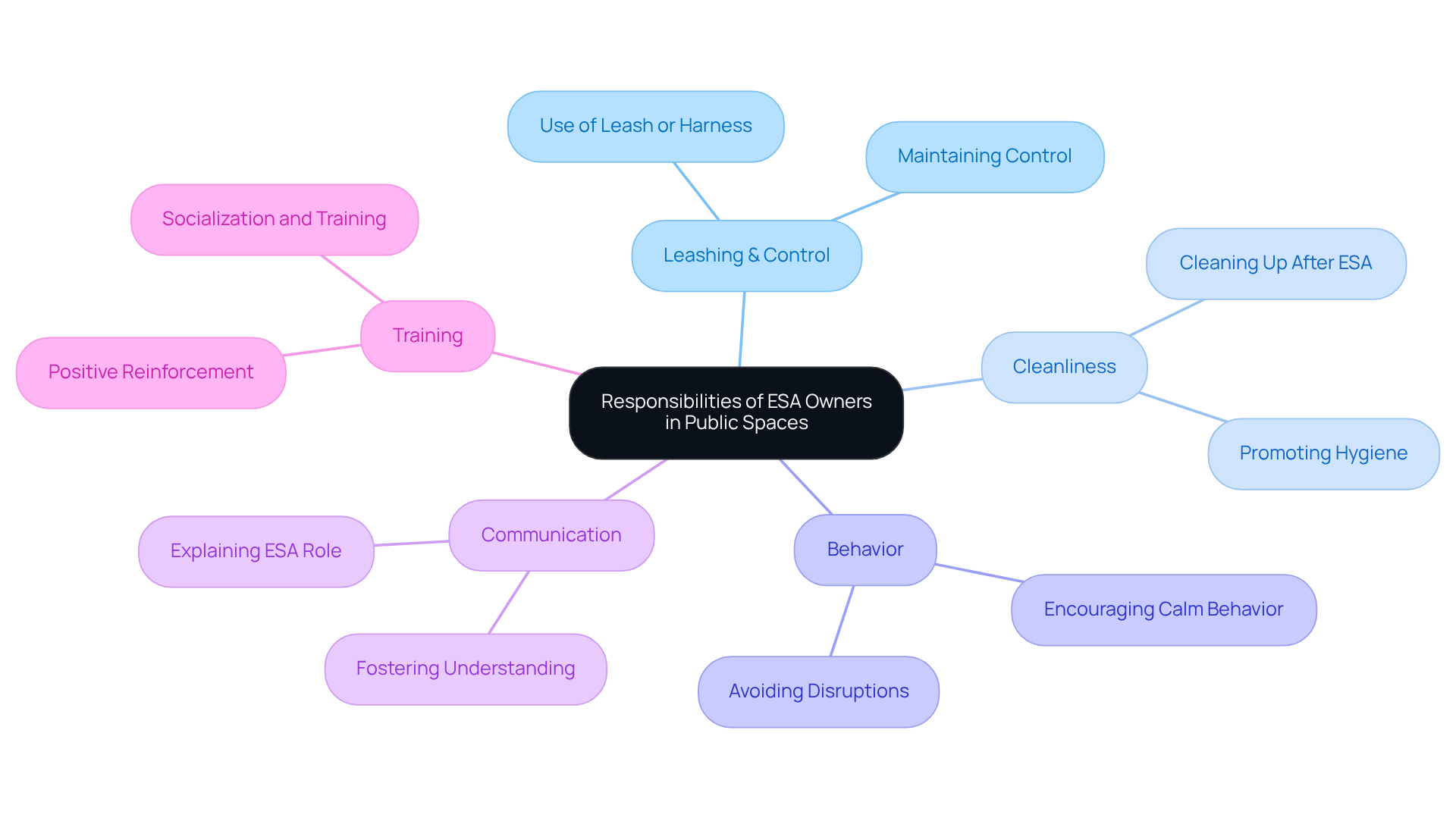
Verify Required Documentation and Legal Protections for ESAs
If you’re seeking a legitimate ESA letter, the journey begins with a certified mental health expert who can confirm your need for a therapy dog. At Wellness Wag, we understand how overwhelming this process can feel, and we offer a streamlined approach to support you every step of the way.
It’s important to be aware of specific requirements, as different housing providers and airlines may have unique documentation needs. Taking the time to verify these details before applying can help ensure compliance with the Fair Housing Act (FHA) and Air Carrier Access Act (ACAA), alleviating some of the stress you might be experiencing.
When traveling or visiting public places, always keep copies of your ESA letter close at hand. This will empower you to advocate for your rights effectively. Familiarizing yourself with your rights under the FHA and ACAA can further equip you to navigate any challenges that may arise regarding whether emotional support dogs can go anywhere.
With Wellness Wag, you can take a quick assessment tailored to your psychological assistance needs. This personalized approach results in a professionally created ESA letter within 24 hours of your consultation, offering you the timely support you deserve. Remember, you are not alone in this journey; we are here to help you find the comfort and companionship you need.
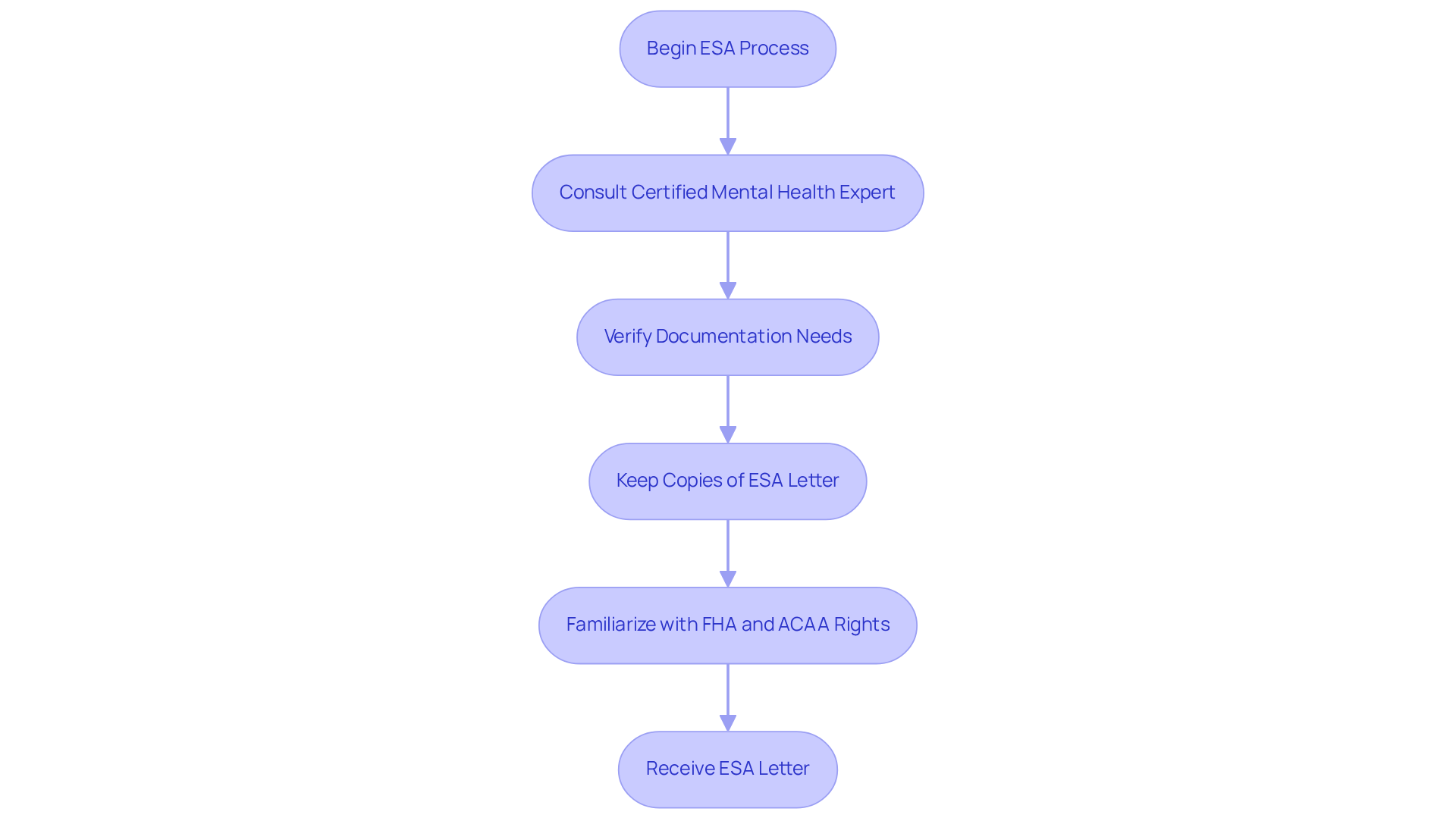
Prepare for Travel with Your Emotional Support Dog
Before making your reservation, it’s important to carefully examine the specific regulations of your chosen airline regarding assistance animals, particularly to find out if emotional support dogs can go anywhere. Many airlines now classify emotional support animals under standard pet policies, raising the question of where can emotional support dogs go anywhere, as they may impose restrictions on size, breed, and behavior. Understanding these regulations is crucial to avoid any complications during your travel. Notably, Air Canada no longer recognizes therapy animals, but psychiatric service dogs can still travel with the right documentation, including a U.S. DOT form and a recommended PSD letter to ensure a smooth check-in. While there are no breed restrictions for service dogs, snub-nosed breeds may face certain limitations.
To ensure a stress-free experience, secure your travel arrangements as early as possible. Airlines often have limited space available for emotional support animals, leading to the question of where can emotional support dogs go anywhere, and reserving ahead of time helps guarantee that you can accommodate your support dog. Additionally, some airlines, including Air Canada, require notification at least 48 hours before departure, along with the necessary documentation. It’s also important to be aware that pet fees can vary based on flight type, and pet carriers must adhere to specific size guidelines.
To help your dog adjust to the travel environment, consider taking them on short trips prior to your flight. This preparation can significantly reduce anxiety and ensure your ESA is comfortable during the journey. Airlines may deny boarding to animals that show signs of illness or discomfort, so having a well-prepared ESA is essential.
When traveling, remember to bring along all necessary items for your ESA, including food, water, and comfort items. Since airlines may not provide food or water during the flight, ensuring your dog has everything they need to stay calm and comfortable is vital.
Most airlines require travelers to submit three forms for approval at least 48 hours before departure. These typically include a Medical/Mental Health Professional Form, a Veterinary Health Form, and a Confirmation of Animal Behavior Form. Failing to provide complete documentation can lead to denied boarding. For Air Canada, ensure that you have the U.S. DOT form completed and submitted in advance.
For example, American Airlines mandates that emotional support animals must be clean, well-behaved, and able to fit under the seat in front of the passenger; however, it raises the question of whether emotional support dogs can go anywhere. Similarly, Delta Air Lines requires four forms for emotional support animals, including a new document verifying appropriate animal training. Alaska Airlines also necessitates three forms of documentation submitted 48 hours prior to departure and may deny boarding to animals exhibiting aggressive behavior or occupying a seat. Understanding these specific requirements can help ensure a smooth travel experience.
Stay informed about any changes in airline policies regarding whether emotional support dogs can go anywhere, as regulations can evolve. For instance, the U.S. Department of Transportation has classified service animals strictly as dogs trained to perform tasks for individuals with disabilities, leading to stricter regulations for emotional support animals. Regularly checking the airline’s website for updates can help prevent last-minute surprises.
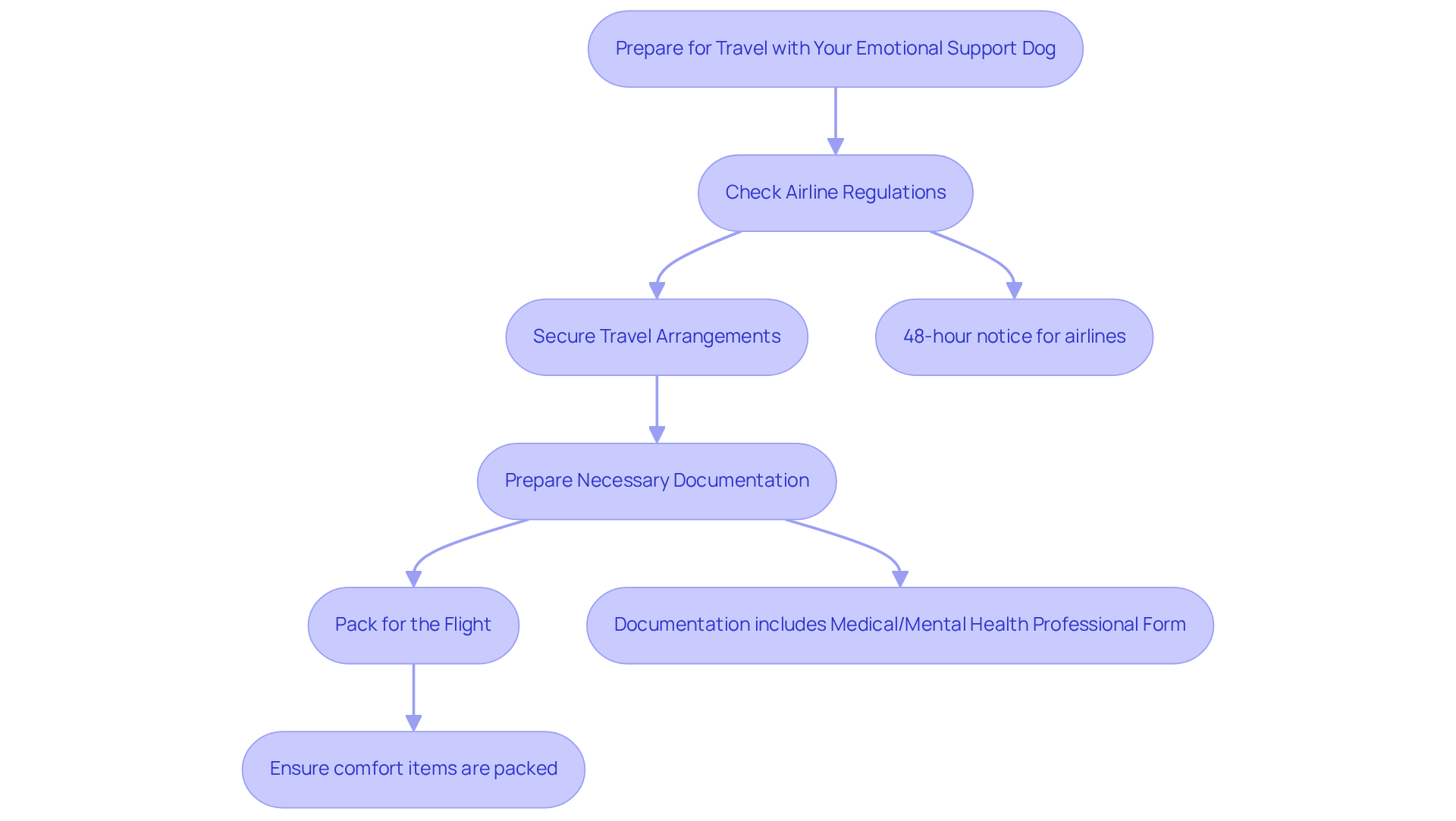
Understand the Impact of Emotional Support Dogs on Mental Health
Emotional Support Animals play a vital role in easing feelings of anxiety, depression, and loneliness. Many individuals have faced overwhelming struggles, especially during challenging times like the pandemic. In fact, studies reveal that 62% of ESA owners reported an improvement in their mental health during this period, underscoring the profound therapeutic benefits these animals provide. The presence of an ESA can significantly alleviate symptoms of anxiety and depression, with 74% of pet owners acknowledging that their pets have positively influenced their mental well-being, according to a survey by the Human-Animal Bond Research Institute (HABRI). Psychologists emphasize that interactions with animals can enhance oxytocin production, a hormone that fosters bonding and reduces stress, further reinforcing the mental health advantages of therapy animals. Dr. Boris Levinson, a dedicated researcher in this field, has observed the remarkable impact animals can have on individuals’ mental health.
Beyond emotional support, these animals also contribute to physical health improvements. Their presence has been associated with lower blood pressure and reduced cholesterol levels, promoting overall well-being. Pet ownership is linked to a decreased risk of heart disease, partly due to the comforting effects of companionship. Moreover, the responsibility of caring for an ESA can instill a sense of routine and purpose in an owner’s life, encouraging healthier lifestyle choices. Research from the American Heart Association suggests that having pets can enhance cardiovascular health and increase physical activity, further highlighting the physical health benefits of emotional support animals.
Emotional support animals also foster social interactions, helping owners connect with others and alleviate feelings of isolation. This social engagement is crucial; 60% of pet owners report that their pets have helped them navigate difficult times, as noted by the National Alliance on Mental Illness (NAMI). By nurturing connections and encouraging physical activity, these support animals contribute to a holistic approach to mental health care, making them essential companions for individuals facing psychological challenges. If you find yourself resonating with these experiences, consider the support that an ESA can offer in your journey toward healing.
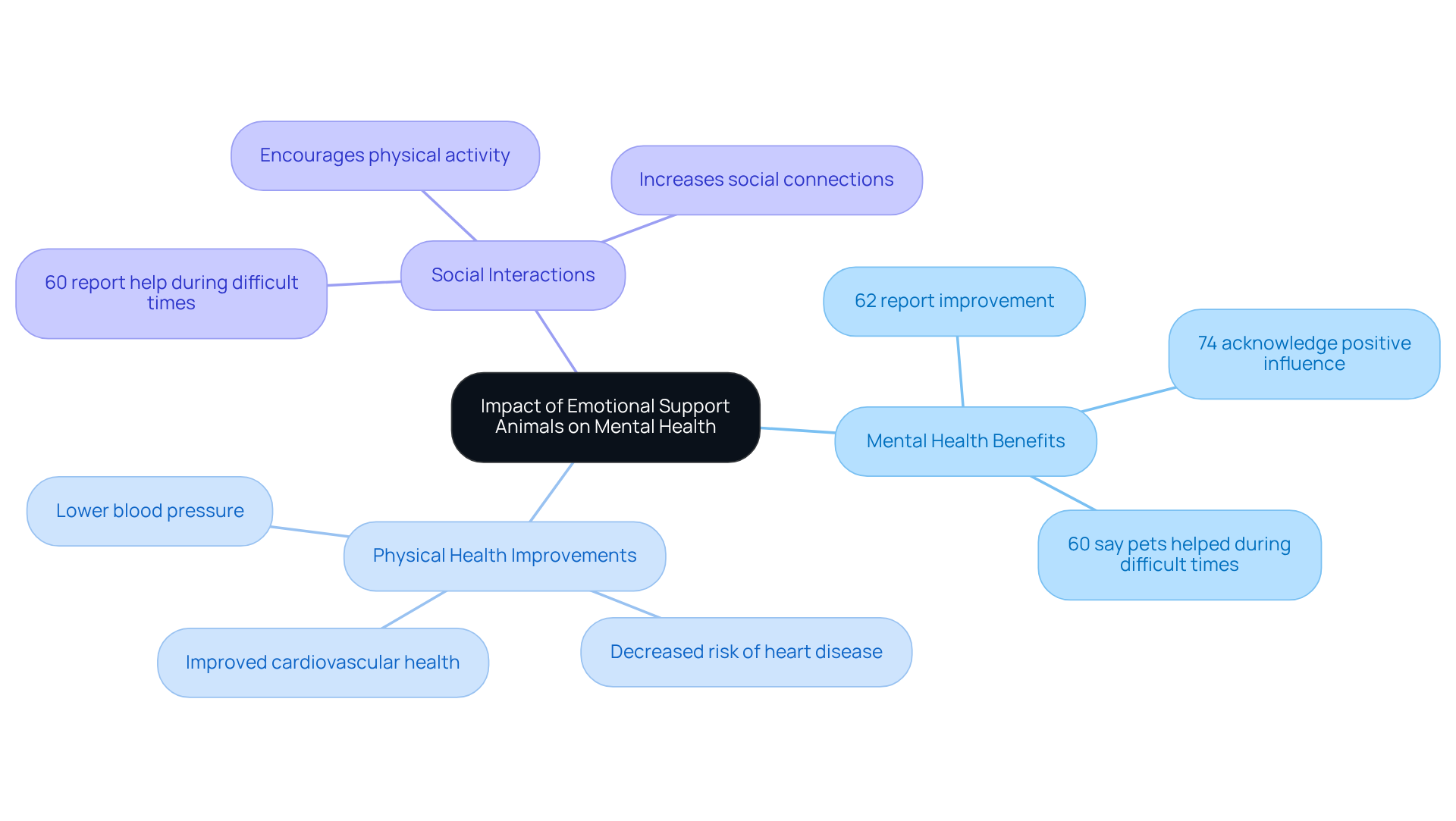
Stay Informed About Changes in ESA Regulations
Stay updated by subscribing to newsletters from mental health organizations and legal resources that provide insights into the latest ESA regulations. It’s important to understand that therapeutic animals differ from service dogs; they offer psychological comfort and assistance to individuals with mental health disorders but are not trained to carry out specific tasks. The question of whether emotional support dogs can go anywhere arises, as they do not have the same legal rights and access to public spaces as service dogs under the ADA. Being aware of any changes that could impact your rights and responsibilities as an ESA owner is crucial for your peace of mind.
Engaging with communities of ESA owners can be a wonderful way to share experiences and stay informed about regulatory updates. Support groups offer valuable resources, emotional support, and a platform for discussing the challenges and successes related to ESA ownership. As Logan Miller states, “The presence of pets adds a layer of consideration as they coexist with other tenants.”
Regularly checking in with licensed mental health professionals regarding any changes in ESA laws that may affect your situation is also beneficial. Their expertise can provide clarity on how new regulations might impact your rights and the legitimacy of your ESA documentation. Remember, “Accommodating an ESA is more than a courtesy. It’s a legal requirement to ensure equal housing opportunities for all.”
Be proactive in understanding and advocating for your rights as an ESA owner. Familiarize yourself with the Fair Housing Act and other relevant laws to ensure you can effectively communicate your needs and protect your rights in housing and travel situations, especially regarding where emotional support dogs can go anywhere. Notably, recent changes to the Air Carrier Access Act (ACAA) have altered the travel rights of ESAs, making it crucial to stay informed. Your journey as an ESA owner is supported by a community that understands and cares about your well-being.
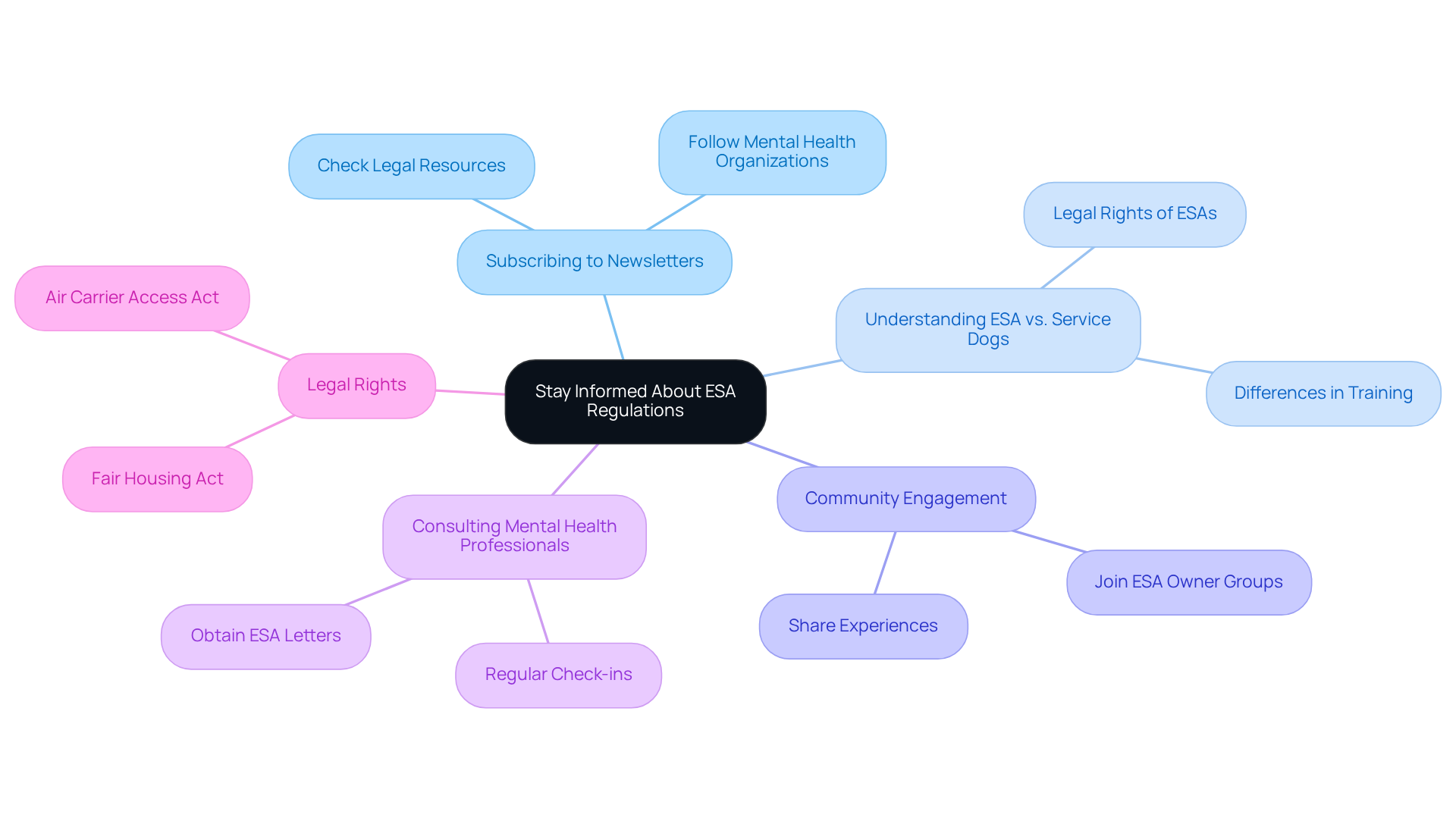
Conclusion
Emotional Support Dogs play a crucial role in providing comfort and companionship to individuals facing mental health challenges. While they are not classified as service animals under the Americans with Disabilities Act, they still enjoy certain legal protections, particularly in housing and travel contexts. Understanding the nuances of where emotional support dogs can go is essential for owners to navigate their rights effectively and ensure a supportive environment for both themselves and their companions.
Many individuals grapple with emotional challenges that can feel overwhelming. The presence of an Emotional Support Animal can be a beacon of hope, offering not just companionship but also a sense of stability and comfort. Key points discussed include:
- The specific regulations surrounding emotional support animals in housing
- The varying airline policies for travel
- The responsibilities of ESA owners in public spaces
It is important to:
- Obtain proper documentation
- Maintain control over the animal
- Be aware of local laws that may impact ESA access
Moreover, the positive mental health benefits associated with having an emotional support animal are significant, enhancing the quality of life for many individuals.
As the landscape of emotional support animal regulations continues to evolve, staying informed and proactive is vital. Engaging with mental health professionals, understanding legal rights, and fostering responsible ownership practices can empower ESA owners to advocate for themselves and their companions effectively. By doing so, the invaluable support that emotional support dogs provide can be recognized and embraced, promoting a more inclusive and understanding society for all. Remember, you are not alone in this journey; support is available, and the bond with your emotional support dog can be a transformative experience.
Frequently Asked Questions
What is an Emotional Support Dog?
An Emotional Support Dog (ESD) is a therapy dog that provides comfort and emotional stability to individuals dealing with anxiety or depression. Unlike service dogs, ESDs are not specially trained to perform tasks for people with disabilities.
What legal protections do Emotional Support Dogs have?
Emotional Support Dogs receive protections under the Fair Housing Act (FHA) and the Air Carrier Access Act (ACAA). The FHA allows ESD owners to live with their animals in no-pet housing without facing additional fees, while the ACAA no longer extends protections for ESDs on flights as of January 2021.
Do Emotional Support Dogs require specialized training?
No, Emotional Support Dogs do not require specialized training. Their role is to provide emotional support, which is validated through documentation from a licensed mental health professional.
How can I obtain an Emotional Support Animal letter?
To obtain an Emotional Support Animal letter, it is advisable to consult a licensed mental health professional. Wellness Wag offers accessible consultations to help individuals secure this documentation.
Are there any additional requirements for Emotional Support Animals in certain states?
Yes, some states have additional requirements. For example, California and Montana require a 30-day therapeutic connection with a licensed mental health professional before issuing an ESA letter. Other states may impose stricter penalties for the misrepresentation of emotional support animals.
Can Emotional Support Dogs be taken to work?
Yes, employees wishing to bring their Emotional Support Dogs to work should discuss their company’s guidelines with their employers. Some workplaces may allow ESDs to enhance employee well-being.
Are there restrictions on where Emotional Support Dogs can go?
Emotional Support Dogs do not have the same access rights as service dogs. However, many businesses may still permit them on their premises, so it is advisable to ask beforehand about their policies.
What are the travel requirements for Emotional Support Dogs on airlines?
Travel requirements for Emotional Support Dogs can vary by airline. For example, Air Canada allows only one cat or small dog in the cabin, which must be at least 12 weeks old and remain in a carrier during the flight. Passengers should also arrive at least 30 minutes early for check-in and verify the airline’s specific policies regarding documentation for their ESD.
Certify Your Emotional Support Animal Today

Why You Can Rely on Us?
At Wellness Wag, we believe your pet deserves care rooted in both science and compassion. Each article is carefully researched, written in clear language for pet owners, and then reviewed by qualified professionals to ensure the information is evidence-based, current, and practical for real-life care. Our goal is to help you feel confident in making informed decisions about your pet’s health and well-being.
Reviewed by
Angela Morris, MSW, LCSW
Angela is a licensed clinical social worker with 20 years of experience in patient advocacy and community mental health. She has assisted numerous clients with ESA evaluations and brings a deep understanding of disability accommodations, ensuring that all information is accurate, supportive, and practical.

Written by :
Lena Park
Last Updated :
August 19, 2025












